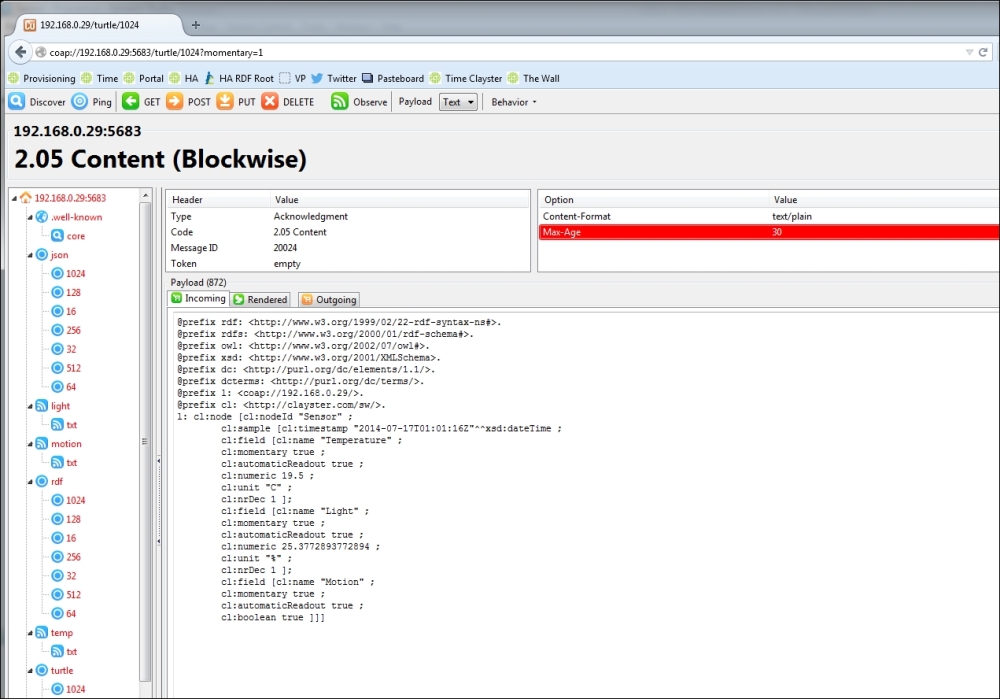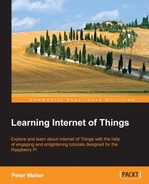CoAP is a very lightweight protocol, and making our sensor interact with CoAP is very easy. First, we will set up a CoAP endpoint. (An endpoint acts both as a client and a server in the HTTP sense.). We can use the CoAP endpoint, CoapEndpoint, defined in the Clayster.Library.Internet.CoAP namespace. Before our main loop, we add the following:
CoapEndpoint CoapEndpoint = new CoapEndpoint ();
Log.Information ("CoAP endpoint receiving requests on port " + CoapEndpoint.Port.ToString ());Tip
If we want to see what communication is being established through CoAP endpoint, we would need to register a LineListener that would output everything to the console, as follows:
CoapEndpoint.RegisterLineListener (new ConsoleOutLineListenerSink (BinaryFormat.Hexadecimal, true));
There are many different types of line listeners available, defined in the Clayster.Library.Internet.LineListeners namespace; you can define your own line listeners by implementing the ILineListener interface.
Our first CoAP resource will be called temp/txt and will publish the current temperature in plain text format. We do this as follows:
CoapEndpoint.RegisterResource ("temp/txt",
"Current Temperature, as text.",
CoapBlockSize.BlockLimit_64Bytes, false, 30, true,
(Request, Payload) =>
{
return FieldNumeric.Format (temperatureC, "C", 1);
});While you can register any class derived from CoapResource as a resource on the CoAP endpoint, we prefer to use the lambda version that implicitly creates a resource for us since the actual resource code is so tiny. In the preceding code, the first parameter defines the name of the resource, in our case, temp/txt. If the IP address of our device is 192.168.0.29, we will be able to access this resource through the use of the coap://192.168.0.29/temp/txt URL. The second parameter provides a descriptive title for the resource. This text will be used when documenting available resources on the end point, as will be described later. The third parameter is the default block size for the resource. When transmitting large payloads using CoAP, the payload will be divided into blocks if it is larger than the default block size. These blocks will then be transmitted to separate datagrams. The fourth parameter tells the endpoint that the resource does not handle any subpaths to the resource (coap://192.168.0.29/temp/txt/example for instance). We provide a default maximum age for the content returned by the resource in the fifth parameter; in our case, we set it to 30 seconds. In the sixth parameter, we tell the endpoint that the resource is observable. This means that subscribers can subscribe to events from this resource and the endpoint will regularly be notifying subscribers of new values. This will happen at least when the maximum age is reached or when the resource triggers a notification manually. Following these parameters, you can provide delegates for the GET, POST, PUT, and DELETE methods correspondingly. We only provide a GET method through a lambda function that returns a string containing the temperature formatted with one decimal and suffixed by a space and the unit C, for example, "23.1 C".
We define a light resource in the same way. Here, we create an observable light/txt resource that returns the light density in percent with a maximum age of 2 seconds:
CoapEndpoint.RegisterResource ("light/txt", "Current Light Density, as text.", CoapBlockSize.BlockLimit_64Bytes, false, 2, true, (Request, Payload) =>
{
return FieldNumeric.Format (lightPercent, "%", 1);
});The previous resources are observable, but they only notify event subscribers when the maximum age is reached. To be able to notify subscribers when something happens, you first need to have access to the CoAP resource. In our case, since these resources are created implicitly, we need to store the implicitly-generated resource. We create a static variable for the motion resource that will inform subscribers whether motion is detected:
private static CoapResource motionTxt = null;
We then register the motion resource, as we did with other resources, but we store the implicitly created resource object at the end:
motionTxt = CoapEndpoint.RegisterResource ("motion/txt", "Motion detection, as text.",CoapBlockSize.BlockLimit_64Bytes, false, 10, true, (Request, Payload) =>
{
return motionDetected ? "1" : "0";
});Here, our motion resource returns a plain text, either 1 or 0, depending on whether motion is detected or not. The resource is observable and updates subscribers with the current status of the motion detector at least every ten seconds. But we want to provide better response time than this without spamming the network. This can be done by manually triggering the event notification mechanism.
In our measurement loop, when we check the status of the PIR sensor, we check whether the state has changed. To notify any subscribers immediately if a change is detected, we simply call the NotifySubscribers() method, as follows:
if (MotionChanged && motionTxt != null) motionTxt.NotifySubscribers ();
Apart from the tiny momentary values published previously, we will also provide the XML, JSON, TURTLE, and RDF data formats through CoAP resources as well. Since these may be large, we must use the block transfer algorithm available in CoAP to divide the contents into multiple packets. This block transfer algorithm is incorporated into the CoAP endpoint class, and all we need to do is provide the desired block size (in bytes) when we register the resource. To make it easier to experiment, we will register our resources for all the available CoAP block sizes, which are defined in the CoapBlockSize enumeration. The available block sizes are 16, 32, 64, 128, 256, 512, and 1,024 bytes per block. The corresponding enumeration values are 0 for 16 bytes/block through 6 for 1024 bytes/block. We begin by looping through the available block sizes, avoiding the BlockLimit_Datagram option, which disables block transfer:
foreach (CoapBlockSize BlockSize in Enum.GetValues(typeof(CoapBlockSize)))
{
if (BlockSize == CoapBlockSize.BlockLimit_Datagram)
continue;
string Bytes = (1 << (4 + (int)BlockSize)).ToString ();We then register an XML resource for the corresponding block size:
CoapEndpoint.RegisterResource ("xml/" + Bytes, "Complete sensor readout, in XML. Control content using " + "query parmeters. Block size=" + Bytes + " bytes.", BlockSize, false, 30, false, CoapGetXml);JSON, TURTLE, and RDF resources are registered in a similar manner. The only things that differ are the resource names, titles, and resource methods, as follows:
CoapEndpoint.RegisterResource ("json/" + Bytes, "Complete sensor readout, in JSON. Control content using " + "query parmeters. Block size=" + Bytes + " bytes.", BlockSize, false, 30, false, CoapGetJson);
CoapEndpoint.RegisterResource ("turtle/" + Bytes, "Complete sensor readout, in TURTLE. Control content " + "using query parmeters. Block size=" + Bytes + " bytes.", BlockSize, false, 30, false, CoapGetTurtle);
CoapEndpoint.RegisterResource ("rdf/" + Bytes, "Complete sensor readout, in RDF. Control content using " + "query parmeters. Block size=" + Bytes + " bytes.", BlockSize, false, 30, false, CoapGetRdf);To return XML from a CoAP resource method, you need to return an XmlDocument object. This way, CoAPEndpoint will know how to encode the response correctly. If you're returning a string value, it will be encoded as plain text, and not XML. We use our XML encoding methods defined earlier, load the XML into an XmlDocument object, and return it as follows:
private static object CoapGetXml (CoapRequest Request, object Payload)
{
StringBuilder sb = new StringBuilder ();
ISensorDataExport SensorDataExport = new SensorDataXmlExport (sb, false, true);
ExportSensorData (SensorDataExport, new ReadoutRequest (Request.ToHttpRequest ()));
XmlDocument Xml = new XmlDocument ();
Xml.LoadXml (sb.ToString ());
return Xml;
}Note that the ReadoutRequest class that parses URL query options takes an HttpServerRequest object. This object contains the query parameters. We can use the ToHttpRequest() method on the CoapRequest object to convert the CoAPRequest object to a corresponding HTTPRequest object. Since CoAP is very similar to HTTP, we can reuse HTTP-based logic easily in this way.
At the time of writing this, there is no CoAP Content-Format for RDF. So we choose to return RDF data as XML data as well since it's the closest option:
private static object CoapGetRdf (CoapRequest Request, object Payload)
{
StringBuilder sb = new StringBuilder ();
HttpServerRequest HttpRequest = Request.ToHttpRequest ();
ISensorDataExport SensorDataExport = new SensorDataRdfExport (sb, HttpRequest);
ExportSensorData (SensorDataExport, new ReadoutRequest (HttpRequest));
XmlDocument Xml = new XmlDocument ();
Xml.LoadXml (sb.ToString ());
return Xml;
}To return JSON from a CoAP resource method, you need to return an array object if the result is an array, or SortedDictionary<string,object> if it is an object. These are classes that are recognized by the pluggable CoAP Content-Format encoders. In our case, we generate JSON using the methods developed earlier and use the JsonUtilities class to parse it and return the correct type of object:
private static object CoapGetJson (CoapRequest Request, object Payload)
{
StringBuilder sb = new StringBuilder ();
ISensorDataExport SensorDataExport = new SensorDataJsonExport (sb);
ExportSensorData (SensorDataExport, new ReadoutRequest (Request.ToHttpRequest ()));
return JsonUtilities.Parse (sb.ToString ());
}As mentioned previously, returning plain text is done by simply returning a string value in the CoAP resource method. Since TURTLE does not have a CoAP Content-Format at the time of writing this, we return it as plain text instead. We use our previously defined method to generate TURTLE, as follows:
private static object CoapGetTurtle (CoapRequest Request, object Payload)
{
StringBuilder sb = new StringBuilder ();
HttpServerRequest HttpRequest = Request.ToHttpRequest ();
ISensorDataExport SensorDataExport = new SensorDataTurtleExport (sb, HttpRequest);
ExportSensorData (SensorDataExport, new ReadoutRequest (HttpRequest));
return sb.ToString ();
}Tip
Creating customized CoAP encoding and decoding is easy. All you need to do is implement one or both of the interfaces, ICoapEncoder and ICoapDecoder that are defined in Clayster.Library.Internet.CoAP.Encoding, in a custom class. There is no need to register the class anywhere. As long as the class has a public default constructor defined (one that takes no parameters), the framework will find it automatically.
The CoAP endpoint registers a resource by itself called .well-known/core. Here, it publishes a Link Format document called the
Constrained RESTful Environments (CoRE) Link Format document. This document contains a list of resources published by the endpoint and some basic information about these documents. This document corresponds in some sense to WSDL documents for web services, even though the Link Format document is very lightweight. It consists of a sequence of resources and some corresponding attributes for each resource.
Tip
The generation of the Link Format document is done automatically. It includes resources, titles, and the observable status. If you want to include more information for a resource, you can override the AppendLinkFormatResourceOptions method in the CoAPResource class to add your own resource attributes to the document. The format of the document is fully described in RFC 6690, which you can read at http://tools.ietf.org/html/rfc6690.
When an entity wants to discover what resources are available on a device, it gets the link document from the .well-known/core resource. We can try this in the Cu Firefox plugin when our sensor has been started. By clicking on the Discover button, the interface downloads the document and populates a tree view to the left with the available resources that are found.
We can also select any of the resources found and try any of the methods in the interface. We can try to get the values of a resource by clicking on the GET button. The Incoming tab will display the results. If we want to observe how a resource varies over time, we need to click on the Observe button instead of the GET button. This also sends a GET query, but with observe options requesting to be notified when the resource is changed. If you send data to a resource, for instance by executing the POST or PUT method, you would need to provide the payload in the Outgoing tab. Any query parameters will be set in the URL as usual. The following image illustrates a GET operation against our TURTLE resource:

